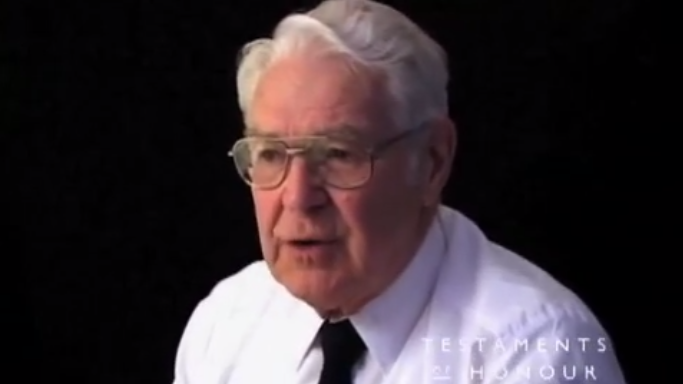The Athabascan (Part 1 of 5)
Heroes Remember
The Athabascan (Part 1 of 5)
Transcript
They called it "the Unlucky Lady", Haida was called "the Lucky
Lady", but she had been hit by glider bombs and I think there
were six killed in the glider bomb attack and there were so many
things. She had been bombed while she was in Newcastle on Tyne
and they changed the names and what should have been the
Athabascan became the Iroquois.
Interviewer: The Iroquois, right.
So you see there was bad luck there.
We left 8 o'clock at night and got away and we were supposed to
cover a mine laying operation and there were a number of MPB's
and mine laying vessels there and we were supposed to do the
outer screen. They got in there and well while they were
getting closer to land the radar in England had picked up two
other boats that were proceeding down the coast and ordered us
to alter course and investigate and go full speed for 20 miles,
which we did. And when we got down there it is was two T-boats,
a T-24 and a T-27 German Elbings.
Interviewer: I don't know what a T-boat is.
It's a torpedo boat, T for torpedo boat.
So, yeah, well anyway we got there we opened fire oh at around 4
o'clock in the morning and we got hits on one and it started to
burn and Athabascan was astern of us and the, the one of the
stories, so its been told, had fired six torpedos our way, one
went down our port side, the captain altered course to, because
he was sure that torpedos had been fired and the unfortunate
part of it, Athabascan got hit in the stern and, right along
side the 4-inch magazine. So there was two explosions, that one
with the stern blown off and another one a little bit later and
of course she sunk. We pursued the one that was not, or I
shouldn't say, we pursued the one that was burning and we
continued to fire at her and she went up, her captain took her
up and put her on the beach, we still fired at her and then we
turned around and came back and before we had left the area
where the Athabascan was the captain ordered
smoke screen so that it would cover it up.
Description
Mr. Hannam talks about the Athabascan, and his experience with it (part 1 of 5). He talks about the Athabascan itself, and the battle that sank her.
Jack Hannam
Mr. Hannam was born in Vancouver, BC on June 19, 1924. At the age of five, shortly after his father's death, he moved to Victoria. His father survived the sinking of the HMCS Charlottetown in the St. Lawrence River but was tragically run down by a drunk driver. He started with the Merchant Marine at the age of 15 and then went on to the navy when he was 17. He joined the reserves Sept. 9, 1941. He served first on the HMCS Camrose and later on the HMCS Haida in both the North Atlantic and off North Africa.
Meta Data
- Medium:
- Video
- Owner:
- Veterans Affairs Canada
- Duration:
- 02:58
- Person Interviewed:
- Jack Hannam
- War, Conflict or Mission:
- Second World War
- Location/Theatre:
- Atlantic Ocean
- Branch:
- Navy
- Units/Ship:
- HMCS Haida
- Rank:
- Leading Seaman
- Occupation:
- Seaman
Related Videos
- Date modified:



